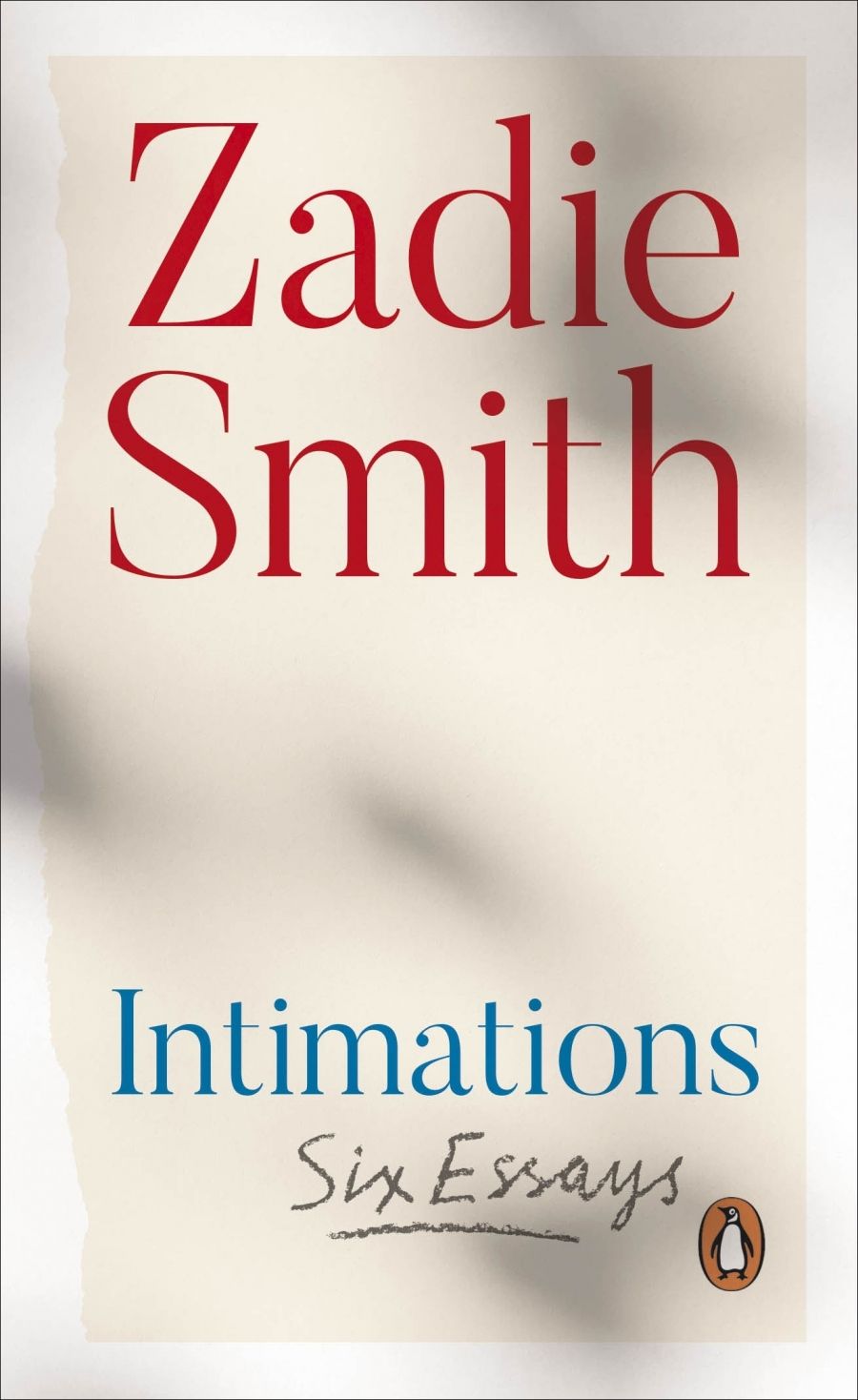
- Free Article: No
- Contents Category: Essay Collection
- Review Article: Yes
- Custom Highlight Text:
On the July afternoon when I first read Intimations, novelist and prolific essayist Zadie Smith’s new book of essays, Melbourne registered its highest number of Covid-19 cases – 484 positives, with two deaths. Since then the daily tolls have risen alarmingly. Midway through the city’s second week of Lockdown 2.0, there is a nebulous feeling of dispiritedness. We mark time as belonging to a pre-Covid era or the present reality. Within the present there exist further subdivisions of pasts and presents marked by social distancing, mandatory mask-wearing, hopefulness.
- Book 1 Title: Intimations
- Book 1 Subtitle: Six essays
- Book 1 Biblio: Penguin, $12.99 pb, 96 pp
- Book 1 Readings Link: booktopia.kh4ffx.net/PX73R
Intimations feels like a message in a bottle washed up on this tempest-stricken shore. While the message is not a cry of ‘HELP!’, it contains cadences found in love notes, being composed as it is of confessions, meditations, observations, regrets. But to view it as a form of billet-doux would be foolhardy; the book is not limited to the interior state, nor is it inconsequential. The bookend essays are located in the personal: the closing essay, ‘Intimations: Debts and Lessons’, is inspired by Marcus Aurelius’s Meditations, but the opening, ‘Peonies’, lambent as its title, extends far beyond it. New York and London are backdrops for larger themes: dehumanisation, the demise of healthcare through corporatisation, art’s purpose and the absoluteness of suffering.
 Zadie Smith (photograph via Penguin)
Zadie Smith (photograph via Penguin)
Smith, a professor of creative writing at New York University, professes to ‘always tell’ her students Susan Sontag’s line, ‘A style is a means of insisting on something.’ What, then, is Smith’s style insisting upon? Besides her mode being in the vein ‘of people thinking aloud’, the type of criticism for which she has previously shown a penchant, it seems to me that she insists on a perspective that is simultaneously cerebral and suffused with feeling – the kind of symbiosis we recognise in the work of Siri Hustvedt and Rebecca Solnit.
In ‘Screengrabs (After Berger, Before the Virus)’, we encounter a series of portraits. It’s not by chance that John Berger has been invoked, for these studies might sit alongside Henri Cartier Bresson’s portraiture, being both revelatory and lucent. There is Barbara, of ‘A Woman with a Little Dog’, a New Yorker who is iconically heroic for her chain-smoking, direct-speaking, willowy listing self; a member of a ‘radical women’s group … [who] discuss the writings of Anaïs Nin’. She’s also radically unlike Chekhov’s delicate ‘Lady with the Little Dog’. The writer alights upon high and low culture references throughout, another familiar element of her style, and one that provokes delight. Barbara vies for our admiration with the unnamed woman whom Smith bumps into at a bus stop in her old stomping grounds of north-west London (‘An Elder at the 98 Bus Stop’). Auntie, of Jamaican descent, is a ‘fertility goddess’ about to visit her doctor so that he might induce menopause at the age of fifty-eight.
The essay doesn’t stop at this point of comic absurdity, as it might have done before the age of Covid. The pandemic pervades everything, imploding inequalities already present. During lockdown, Smith’s mother discloses a horrifyingly violent act that took place on Stonebridge Estate, the same housing estate where the Auntie lives. Symbols of containment haunt Intimations, and instances of entropy (racism, ageing) and destruction (rising death tolls, violence) create an oppressive atmosphere. But there are also signs of fecundity and luxuriant beauty, even when they are merely echoes of themselves, as in the case of the ghostly peonies or Jamaica’s bougainvillea. Humour, often directed at herself, runs as a thick vein throughout.
Smith has previously explored particular junctures in time. In Feel Free: Essays (2019) she wrote out of a ‘bygone world’, the optimistic period of pre-Brexit Britain and a pre-Trump United States. Time, its significance and its fractured nature, is a motif. All six essays are anchored by time, even as they transmute it. Smith returns here to themes with which she is deeply familiar: race, class, and gender. These essays return to the subject of the vulnerable, spilling forth compassion without sentimentality, at times elegiac in tone. In Man’s Search for Meaning (1959), Viktor Frankl espoused a perspective of ‘tragic optimism’. Smith despairs at the state and society, but her optimism is located in the individual and community.
We search for solace. Smith reaches for Marcus Aurelius, I reach for Smith. Intimations, with its positioning that is both intimate and encompassing, provides the solace I seek. The pathogen leaks into our lives, our dreams. Uncontained, it has held up a mirror to inequitable systems, our disregard for fellow humans on the margins. Perhaps the antidote to these fragile times, of distancing and isolation, is a spirit of generosity as embodied in a literary work. For although Smith claims that ‘writing is control’, the writer’s essays contain another kind of porousness altogether; an expansion of experience, of thought, of self.


Comments powered by CComment